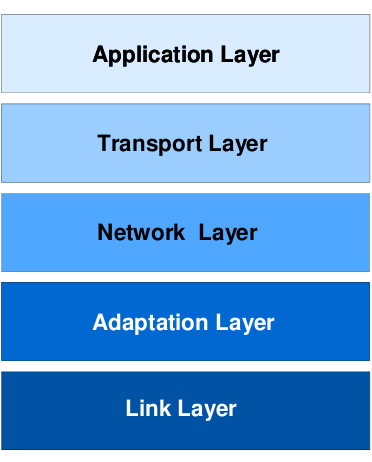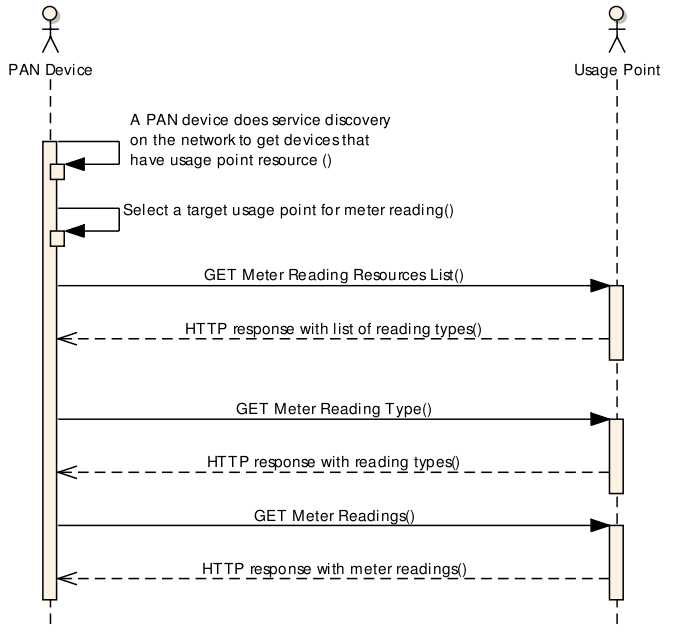|
|
ZigBee Smart Energy
ZigBee Alliance recently published technical requirements to implement ZigBee Smart Energy Profile 2.0 on ZigBee, HomePlug, Wi-Fi, Ethernet, and other IP-capable platforms. The purpose of this document is to provide a networking and application integration platform to exchange messages among customer smart meters and the energy provider. The specification is mainly defined by the Internet Protocol Stack layers (Fig. 1). However, an adaptation layer between the link layer and the network layer is necessary to act as a bridge among Ipv6 and selected substrates.

Fig. 1. ZigBee Smart Energy Profile Layer Model [1].
These protocols support a variety of functions such as:
- Demand Response & Load Control
- Directed Messaging
- Public Messaging
- Price
- Pre-Payment
- Metering
- Plug-in Electric Vehicle
- Distributed Energy Resource Management
- Billing.
Application layer
The core of the application layer ZigBee Smart Energy [2] is the RESTful architecture. The REST design pattern uses HTTP actions (GET, PUT, POST, and DELETE) to define the application services. For example, a personal area network (PAN) can offer to read a meter (Fig. 2).

Fig. 2. Use Case - Get meter reading [2].
- The PAN first discovers the service, then, a list of resources is extracted.
- A meter is then selected and a reading type is chosen.
- A final GET request is sent to read the meter values.
Transport Layer
Since the application is based on HTTP, Transmission Control Protocol (TCP) is required. Also, all devices must support the User Datagram Protocol (UDP) beside TCP.
Network Layer
The Smart Energy 2.0 Profile will use Internet Protocol Version 6 (Ipv6). The following IPv6 functionnalities must be supported:
- Addressing Architecture [3]: IPv6 addresses are 128-bit addresses. There are three types of addresses : unicast, anycast, and multicast.
- Stateless Address Autoconfiguration [4]: The stateless machanism allows a host to create its addresses using local information and minimal information from routers.
- Neighbor Discovery [5]: Similar to Address Resolution Protocol (ARP) in IPv4, however in IPv6 it is included in the protocol without additional packet exchange.
Adaptation Layer
IPv6 requires the maximum transmission unit (MTU) to be at least 1280 bytes compared to 127 bytes in 802.15.4. Thus, IEEE 802.15.4 devices will use 6LoWPAN [6] adaptation layer. 6LoWPAN protocol provides encapsulation and compression for IPv6 packets to be sent on 802.15.4 networks.
Link Layer
The link layer is based on IEEE 802.15.4. However, ZigBee Smart Energy is designed to work with a variety of protocols such as IEEE 802.3 (Ethernet), IEEE 802.11 (Wi-Fi), WiMAX, and so on. IEEE 802.15.4 networks are limited to 65535 nodes because the address length is limited to two bytes. In reality IEEE 802.15.4 networks should be far below this limit since large networks are decomposed into small networks.
References
[1]
|
ZigBee Alliance,
“ZigBee Smart Energy Profile 2.0 Technical Requirements Document,”
www.zigbee.org, 11 March, 2011.
|
[2]
|
ZigBee Alliance,
“ZigBee Smart Energy Profile 2.0 Public Application Protocol Specification,”
www.zigbee.org, March, 2011.
|
[3]
|
R. Hinden, and S. Deering,
“IP Version 6 Addressing Architecture,”
RFC Editor, 1998.
|
[4]
|
T. Narten, and E. Nordmark, and T. Narten,
“Neighbor Discovery for IP Version 6,”
RFC Editor, 1998.
|
[5]
|
X. Ma, and W. Luo,
“The Analysis of 6LowPAN Technology,”
Workshop on Computational Intelligence and Industrial Application, vol. 1, no. 1, pp. 963-966, Dec. 2008.
|
|
|
|
| |